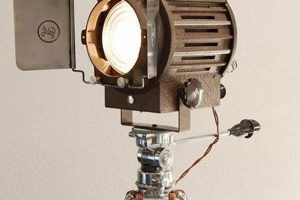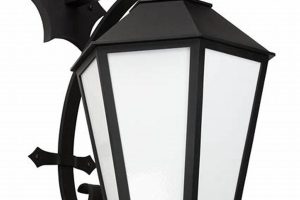Illuminating public thoroughfares in bygone eras, these fixtures represent more than mere light sources; they are artifacts reflecting specific periods in design and technology. Examples range from ornate gas lamps of the Victorian era to the streamlined electric models prevalent in the mid-20th century, each illustrating advancements in lighting and urban aesthetics.
These historical illuminants offer several advantages, beyond their basic function. They contribute significantly to the character and visual appeal of urban and rural landscapes, providing a tangible link to the past. Their presence can enhance property values and foster a sense of community identity. Historically, the progression of public illumination mirrored societal changes, reflecting advancements in safety, technology and urban planning.
The following sections will delve into the materials used in their construction, the various styles that have emerged over time, considerations for their restoration and preservation, and the impact these antique luminaries have on modern urban design.
Preservation and Integration
The preservation and continued use of older public lighting demand thoughtful planning and execution. These tips address key considerations for maintaining their historical integrity while adapting them for modern use.
Tip 1: Document Existing Conditions: A thorough assessment of the fixture’s current state is crucial. Detailed photographs, material analysis, and structural evaluations should be conducted to understand its unique characteristics and identify areas needing repair or restoration.
Tip 2: Prioritize Authentic Restoration: When possible, use historically accurate materials and techniques. Sourcing compatible replacement parts or employing skilled artisans familiar with traditional methods ensures the restored fixture remains true to its original design.
Tip 3: Consider Adaptive Reuse: Complete restoration may not always be feasible or desirable. Adaptive reuse involves incorporating modern lighting technology, such as LED systems, within the existing framework. This approach balances energy efficiency with historical preservation.
Tip 4: Address Structural Integrity: Public safety is paramount. Thoroughly examine the structural components of the artifact, including the pole, base, and mounting hardware. Repair or replace any compromised elements to ensure the fixture’s stability.
Tip 5: Ensure Compatibility with Surroundings: The installation environment significantly influences the impact of the luminaire. Carefully consider the surrounding architecture, landscaping, and pedestrian traffic patterns when determining placement and illumination levels.
Tip 6: Comply with Regulations and Codes: All restoration and installation work must adhere to local and national regulations regarding electrical safety, structural stability, and accessibility. Consult with qualified professionals to ensure compliance.
Tip 7: Develop a Maintenance Plan: Implement a proactive maintenance schedule to prevent future deterioration. Regular cleaning, inspection, and timely repairs will extend the life of the luminaire and minimize the need for costly overhauls.
By following these guidelines, communities can successfully preserve these historical luminaires, ensuring they continue to illuminate public spaces and contribute to the character of the environment for generations to come.
The following sections will explore specific case studies of restoration projects and delve into the impact that restored or replicated designs have on urban planning.
1. Aesthetic Design
The aesthetic design of historical public lighting significantly impacts urban perception and atmosphere. These luminaires, often prominent features in streetscapes, contribute substantially to the overall visual character of a specific area. For example, the intricate ironwork and graceful curves of Victorian-era gas lamps evoke a sense of historical elegance and refinement, creating a distinct ambiance absent from areas illuminated by modern, utilitarian fixtures. This inherent beauty has led to preservation efforts in many historic districts, highlighting their value as cultural artifacts.
The design of luminaries, influenced by prevalent artistic movements and technological capabilities, reflects societal values and aspirations. Art Deco-era designs, with their geometric shapes and streamlined forms, mirrored the optimism and modernity of the early 20th century. The selection of materials, such as cast iron, bronze, or pressed glass, further contributes to the aesthetic qualities and reflects the manufacturing capabilities of the time. A deep understanding of these design elements is paramount when undertaking restoration projects. In instances of replicating luminaires for historical districts, precision in capturing the original design is essential for maintaining the district’s character.
In conclusion, the aesthetic design is an integral element, influencing urban identity and contributing to the preservation of historical heritage. The challenges of replicating or restoring them demand a careful balance of technical skill and artistic sensibility, underscoring their importance in shaping the visual environment. Their impact extends beyond mere illumination; they actively mold the character and perception of the areas they inhabit.
2. Historical Context
Historical context is inextricable from the definition and value of antique public lighting. These fixtures are not merely sources of illumination; they are tangible representations of specific periods in urban development, technological advancement, and societal values. The style, materials, and technology embodied in a gas lamp from the late 19th century, for instance, directly reflect the industrial capabilities and urban planning philosophies of that era. Understanding this history provides crucial insight into the artifacts original purpose and intended impact on the community. As an example, the shift from gas to electric models mirrored advancements in electricity distribution and signaled a significant change in urban infrastructure.
Furthermore, the historical context offers essential clues for restoration and preservation efforts. Knowing the original manufacturing processes and materials used in a fixture informs the selection of appropriate repair techniques and replacement components. Without this knowledge, restoration attempts risk compromising the artifact’s authenticity and potentially damaging it irreparably. For instance, replacing a delicate glass globe from an Art Deco design with a modern, mass-produced substitute would diminish the fixture’s historical integrity and aesthetic appeal. A deeper appreciation also allows us to avoid repeating historical mistakes in urban planning and design.
In conclusion, the historical context is a critical component. It illuminates the artifact’s origin, function, and significance within the broader narrative of urban history. Ignoring this context reduces this to a mere object, devoid of its cultural and historical value. Careful consideration of the historical backdrop enhances the value and promotes responsible preservation, benefiting future generations by providing tangible connections to the past.
3. Technological Transition
The evolution of public lighting is inextricably linked to technological advancements. The transition from gas to electric models exemplifies the impact of scientific breakthroughs on urban infrastructure and aesthetics. Gas lamps, prevalent in the 19th century, provided illumination through controlled combustion, often requiring manual operation and posing safety concerns. The introduction of electricity revolutionized public lighting, offering increased brightness, improved safety, and the potential for automated control. This transition was not merely a change in power source but a fundamental shift in urban design and societal expectations. For example, cities like London and New York gradually replaced gas lamps with electric fixtures, reflecting technological progress and a growing demand for enhanced public safety.
The move to electric lighting also facilitated experimentation with new designs and materials. Early electric fixtures, while often mimicking the aesthetic of gas lamps, soon evolved to incorporate new forms and functionalities. The development of incandescent and, later, fluorescent and LED technologies, further transformed the design and efficiency. The design of such streetlights, from early models to the streamlined forms of the mid-20th century, illustrates the continuous interplay between technological possibility and urban aesthetic preferences. Many designs of vintage luminaires now incorporate LED technology for increased efficiency and longevity, illustrating a modern adaptation of past designs.
In summary, the history is a narrative of ongoing technological transition. It illustrates how innovations in energy production and lighting technologies have reshaped urban landscapes. Understanding this transition is crucial for the responsible preservation and restoration of historical fixtures, as it allows for the seamless integration of modern technology while respecting the artifact’s historical integrity. This understanding also provides valuable insights into how technology will continue to shape urban environments in the future.
4. Restoration Complexities
The restoration of historical public lighting introduces a unique set of challenges that demand a comprehensive understanding of historical manufacturing techniques, material science, and contemporary engineering practices. The successful rehabilitation of these artifacts requires more than mere replacement of damaged components; it necessitates a nuanced approach that balances preservation of historical integrity with the functional requirements of modern urban environments.
- Material Degradation Assessment
Identifying the extent and type of material degradation is crucial to the restoration process. Materials commonly used, such as cast iron, bronze, and glass, are susceptible to corrosion, fatigue, and environmental damage. An accurate assessment of these issues determines the appropriate conservation methods. For instance, the analysis of corrosion on a cast iron pole informs the selection of suitable cleaning and protective coatings, preventing further deterioration while maintaining the pole’s structural integrity.
- Authenticity vs. Functionality Balance
Maintaining historical accuracy while ensuring the restored luminaire meets contemporary safety and performance standards is a primary challenge. Replacement components, if required, must be either historically accurate reproductions or carefully selected modern alternatives that do not compromise the artifact’s aesthetic or historical value. Introducing LED lighting within an antique fixture exemplifies this challenge. The LED system must provide adequate illumination while remaining visually discreet and compatible with the fixture’s original design.
- Sourcing and Fabrication of Replacement Parts
Many components are no longer commercially available, requiring custom fabrication or the sourcing of salvaged parts from similar artifacts. This process demands skilled artisans familiar with traditional manufacturing techniques. The replication of a specific type of glass globe, for example, may require knowledge of historical glassblowing methods to achieve the correct color, texture, and shape. This level of specialization often increases the cost and complexity of the restoration process.
- Structural Integrity Evaluation and Reinforcement
Historical luminaires, particularly those constructed from cast iron or other heavy materials, may suffer from structural weaknesses due to age, corrosion, or previous damage. A thorough evaluation of the structural integrity is essential to ensure the fixture’s safety. Reinforcement techniques, such as welding or the application of composite materials, may be necessary to address these weaknesses without compromising the original design. Careful engineering analysis is crucial to determine the appropriate reinforcement methods.
These complexities underscore the need for a multidisciplinary approach to the restoration of historical public lighting. Effective restoration demands collaboration between historians, engineers, conservators, and skilled artisans, ensuring that these tangible links to the past are preserved for future generations. Successfully navigating these challenges not only preserves these artifacts but also enriches the urban landscape, fostering a sense of continuity and historical identity.
5. Urban Integration
The successful integration of historical luminaires into contemporary urban environments necessitates a careful consideration of aesthetic, functional, and contextual factors. It is not merely about placing old lights in modern settings; rather, it requires a deliberate and thoughtful process to ensure that the fixtures contribute positively to the urban fabric. This includes assessing the visual harmony between the fixtures and surrounding architecture, guaranteeing adequate illumination levels for safety and usability, and respecting the historical context of the chosen location. Failure to address these factors can result in visual discord, inadequate lighting, or even the marginalization of the artifact’s historical significance.
Practical examples demonstrate the impact of thoughtful urban integration. Consider the restoration and re-installation of gas lamps in historic districts. These lamps, while providing a soft, ambient light, also reinforce the district’s historical character, attracting tourism and enhancing property values. Their successful integration, however, requires careful planning to ensure they meet modern safety standards and do not contribute to light pollution. Conversely, poorly integrated luminaires can detract from the overall urban experience. A modern, high-intensity fixture placed adjacent to a historical building, for instance, can overwhelm the building’s aesthetic and disrupt the historical ambiance. The integration strategy should consider these potential pitfalls, ensuring the result enriches rather than detracts from the overall experience.
In conclusion, urban integration is a critical component of these projects. It demands a nuanced approach that blends historical preservation with contemporary functionality. By carefully considering aesthetic compatibility, lighting requirements, and historical context, planners and designers can ensure that these elements contribute to the richness and vibrancy of the urban environment. The challenges inherent in the integration process underscore the need for collaborative efforts involving historians, urban planners, lighting designers, and community stakeholders to ensure that these valuable pieces of history are preserved and appreciated for generations to come.
Frequently Asked Questions
The following section addresses common inquiries regarding the identification, restoration, and integration of these artifacts into modern urban landscapes.
Question 1: How is a truly old one differentiated from a modern replica?
Authenticity is determined through a combination of factors. These factors includes material analysis, manufacturing techniques, and historical documentation. Consultation with experts is advised for definitive authentication. The presence of specific manufacturing markings or unique patinas can indicate authenticity.
Question 2: What are the primary challenges in restoring these fixtures?
Restoration faces challenges related to material degradation, sourcing replacement components, and ensuring structural integrity. Maintaining historical accuracy while meeting modern safety standards also poses a complex challenge. Replication of components often requires the employment of skilled artisans.
Question 3: What is the typical lifespan of a restored one?
The lifespan varies significantly based on the quality of restoration, environmental conditions, and the type of lighting technology employed. With proper maintenance, a well-restored fixture can function for several decades. Regular inspection and preventative maintenance are crucial.
Question 4: What are the best practices for integrating the subject into modern urban design?
Successful integration demands a careful balance between historical aesthetics and contemporary functionality. Planners and designers must consider the fixture’s visual harmony with surrounding architecture, adequate illumination levels, and respect for the historical context. This process avoids visual dissonance and ensures the artifact enhances the urban environment.
Question 5: Is it permissible to convert a gas lamp to electric?
Conversion is possible and often necessary to meet modern safety and efficiency standards. However, such conversion should be conducted carefully to preserve the fixture’s historical integrity. The use of subtle, period-appropriate lighting elements is recommended.
Question 6: What are the legal and regulatory considerations for installing reclaimed examples?
Installation is subject to local and national regulations regarding electrical safety, structural stability, and accessibility. Compliance with these regulations is mandatory. Consultation with qualified professionals is essential to ensure adherence to applicable codes.
In conclusion, understanding the nuances of these artifacts enables informed decisions regarding their preservation and integration, enhancing the aesthetic and historical value of urban landscapes.
The following sections will explore specific case studies of restoration projects and delve into the impact that restored or replicated designs have on urban planning.
Concluding Remarks on Vintage Street Light
The preceding exploration has illuminated the multi-faceted nature of vintage street light, extending beyond its basic function of illumination. From aesthetic considerations and historical context to technological transitions, restoration complexities, and urban integration strategies, these fixtures represent a tangible connection to the past, embodying the technological and artistic sensibilities of their respective eras. Their enduring presence shapes urban landscapes, contributing to a sense of historical identity and cultural continuity.
The responsible preservation and thoughtful integration of vintage street light demand a commitment to historical accuracy, technical expertise, and collaborative planning. As communities continue to evolve, the careful stewardship of these artifacts will ensure that future generations can appreciate their beauty, understand their history, and benefit from their presence in the urban environment. Ongoing efforts to document, restore, and adapt such items will be critical in preserving the legacy of urban illumination for years to come.







![Shop Antique Vintage Sconce Lights - [Your Brand/Shop Name] Safem Fabrication - Precision Engineering & Custom Manufacturing Solutions Shop Antique Vintage Sconce Lights - [Your Brand/Shop Name] | Safem Fabrication - Precision Engineering & Custom Manufacturing Solutions](https://roopevintage.com/wp-content/uploads/2025/06/th-3877-300x200.jpg)